Click on the photo for a high-res gallery of photos from the Ford SMT Lab
Between the Washington, D.C. and Chicago Auto Shows, AutoblogGreen got invited to visit Ford's Sustainable Mobility Test Lab in Dearborn, MI. The SMT lab is the birth place of all the advanced alternative fuel vehicles that Ford is creating in an effort help reduce the automobile's effect on the environment. I met up with Mujeeb Ijaz, who is the manager of Fuel Cell Engineering in the Research and Advanced Engineering department at Ford. Mujeeb gave me a tour around the garage area and rundown on some of the stuff they are working on before we went out for a drive.
In addition to a couple of Focus FCVs, the garage we were in contained two Explorers and the HySeries Drive Edge that was unveiled at the DC Auto Show. The first Explorer we looked at was primarily a packaging and engineering mule. In the world of automotive development, a mule is development vehicle that's based on an existing vehicle and has development parts from new vehicles to test purposes. Many of the spy photos you see published that look like current vehicles that have mutated bodywork are mules. The Explorer mule was being used to test fuel cell and hydrogen storage packaging alternatives. The interior is gutted except for the front seats. The hydrogen storage tank is mounted longitudinally down the center of the vehicle and the fuel cell sits on top of the front electric motor under the hood.
Between the Washington, D.C. and Chicago Auto Shows, AutoblogGreen got invited to visit Ford's Sustainable Mobility Test Lab in Dearborn, MI. The SMT lab is the birth place of all the advanced alternative fuel vehicles that Ford is creating in an effort help reduce the automobile's effect on the environment. I met up with Mujeeb Ijaz, who is the manager of Fuel Cell Engineering in the Research and Advanced Engineering department at Ford. Mujeeb gave me a tour around the garage area and rundown on some of the stuff they are working on before we went out for a drive.
In addition to a couple of Focus FCVs, the garage we were in contained two Explorers and the HySeries Drive Edge that was unveiled at the DC Auto Show. The first Explorer we looked at was primarily a packaging and engineering mule. In the world of automotive development, a mule is development vehicle that's based on an existing vehicle and has development parts from new vehicles to test purposes. Many of the spy photos you see published that look like current vehicles that have mutated bodywork are mules. The Explorer mule was being used to test fuel cell and hydrogen storage packaging alternatives. The interior is gutted except for the front seats. The hydrogen storage tank is mounted longitudinally down the center of the vehicle and the fuel cell sits on top of the front electric motor under the hood.
There's lots more - pictures, video and text - after the jump
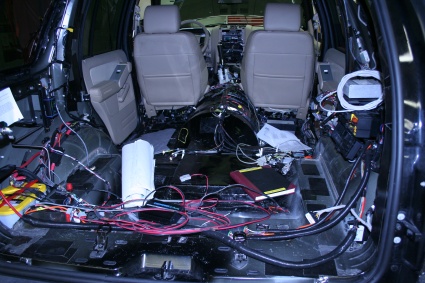
The inside of the fuel cell Explorer mule
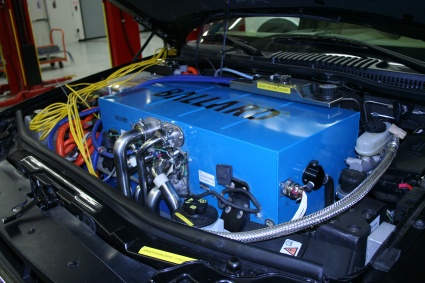
Under the hood of the fuel cell Explorer
Next up was the fuel cell Explorer that was shown in November at the Los Angeles auto show. This truck is primarily being used for field testing and was packaged to minimize the impact of the fuel cell system on interior volume. Unlike the Focus, where the entire trunk was consumed by the hydrogen tank, this Explorer also has the tank down the center tunnel like the mule. The tunnel is a bit wider than standard, but the six-passenger capacity of the vehicle is maintained as is the rear cargo volume. This truck is being driven on a daily basis by Ford engineers and managers and has accumulated over 18,000 trouble-free miles in the year since it was completed.
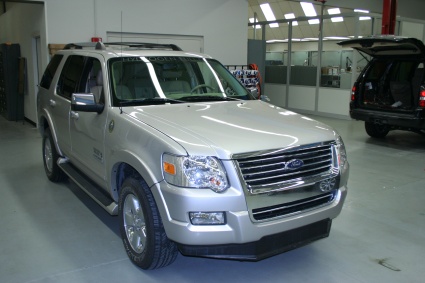
The fuel cell Explorer
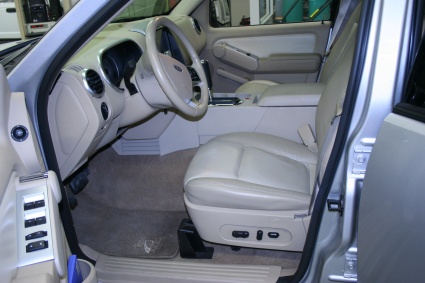
The slightly wider tunnel of the fuel cell explorer
The Explorer is configured as a parallel hybrid with the fuel cell driving the electric motors directly, and the NiMH batteries providing a boost when extra power is needed for acceleration. Driving the Explorer is pretty much the same as a standard unit, aside from the silent drive system. The startup sequence is the same as Focus: key-on, wait 15 seconds for the stack to power up, put it in drive and off you go. Cruising around Dearborn was uneventful, with the navigation screen at the top of center stack providing a live graphic of the drive-train showing the hydrogen level, fuel cell usage and regenerative braking status. After we got back to the lab, we moved on to the HySeries Drive Edge.
The Edge is powered by the same drive-train as the recent Airstream concept. As Mujeeb explained it, the Edge was built to demonstrate the HySeries drive in a real fully functional vehicle, while the Airstream was built to demonstrate some of the possible design alternatives that are facilitated by the new propulsion system. While the aesthetics of the Airstream are debatable, and most people were uninspired (to put it mildly), there are certainly a lot of new directions available to designers now.
The technology is another story. Thanks to the relatively small motors mounted at each axle, the chassis packaging is more akin to the skateboard design shown by GM several years ago than the E-Flex platform used in the Volt. However, like E-Flex, HySeries is designed to be flexible, allowing for alternative auxiliary power modules or even all battery power. The fuel cell could easily be replaced by an internal combustion engine laying flat under the floor, and driving a generator. When I arrived, the Edge was plugged in with a standard extension cord going to a 110V outlet. The electrical plug is on the front fender just ahead of the driver's door. The hydrogen filler is on the rear fender also on the driver's side. With the hood open the engine compartment appears almost empty, with the relatively small motor sitting low in the chamber and most of the space that is normally packed full of 3.5L V-6 empty. Mujeeb explained that this was done on purpose as a way of demonstrating how little space is taken by the electric drive-train.
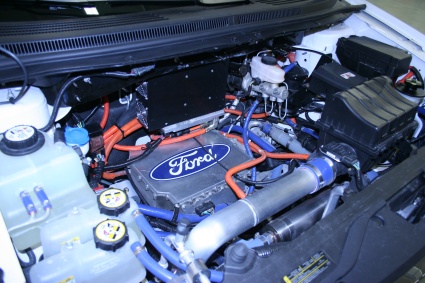
The almost-empty engine compartment of the Edge
Unlike the Focus and Explorer, starting the Edge was just a matter of turning on the key, putting the shifter in drive and heading out. Because the Edge runs primarily off the battery, as long as there is some charge, there is no waiting. The fuel cell starts automatically based on the charge level, or it can be turned on manually with a switch on the dash. Ford did some work on the compressor to eliminate the whine that was present in the Focus FCV, and it shows. The only sound in the Edge was the roar of the 22" tires on the pavement. Speaking of those tires, a big chunk of the 1,000 lbs of extra this Edge carries is directly attributable to the wheels and tires.
Although the 22" rims look great, giving a very aggressive stance to the Edge, they weigh 150lbs more than the standard 18" package. Another substantial chunk of the extra mass comes from all the fiberglass that's used to cover those huge tires. Since returning the Edge from Washington a few days ago, they have been running it through a laser scanner so that they can produce a duplicate set of carbon-fiber parts to replace the fiberglass. As always, in spite of the weight, the electric drive provides good acceleration thanks to the constant torque of the electric motors and quick juice provided by the lithium batteries. The CUV's handling feels heavy, because it is, but otherwise feels normal.
The Edge has what Mujeeb referred to as "pedal off" regenerative braking. When you lift off the accelerator, the regen kicks in until you hit the brakes, and then disables. The brake system is the standard Edge setup with hydraulic brakes, and ABS, traction and stability control. Although this doesn't maximize the amount of regen available, it does eliminate the problem of blending regen with friction braking. Getting smooth, transparent blending of friction and regenerative braking is very difficult and requires an electro-hydraulic brake system, which adds a lot cost and potential failure modes. Since the Edge doesn't need this, the braking feels perfectly normal, with no sudden changes as it transitions from regen to friction braking.
Unlike the Prius, this Edge will not get stranded on a slick slope when the electric power is cut to zero, thanks to the standard brake and engine traction control system. In those instances when even a full function traction control system can't get you going, a TCS disable switch in the roof console allows the driver to turn the system off. The regenerative braking also allows for some driver input, via a switch on the console that controls the amount of regen that is used. Switching to Max Regen mode doubles the amount of energy that goes back to the battery and the amount of "engine braking" you get when you lift off the accelerator.
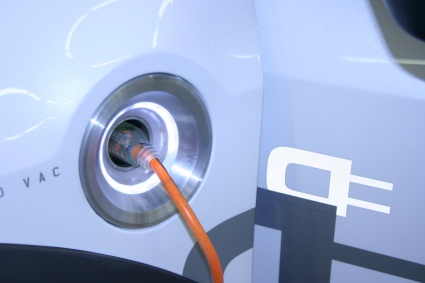
The glowing plug socket on the Edge
The only unusual part of the drive was sitting at a red light on Michigan Avenue in Dearborn,and looking over to see a woman sitting in the car beside me, gaping open open mouthed and pointing at glowing plug socket on the fender. When the Edge is plugged in a LED ring around the socket glows blue indicating the battery is charging. It turns out that when you turn the headlights the charging light also comes on. So the combination of the highly reflective side graphics, big wheels and fenders and unusual lighting draws some attention. Overall, the driving experience was pretty much, one of driving a totally silent Ford Edge carrying a full load of cargo.
A quick video walk-around of the HySeries Edge
Back at the garage, the discussion turned to batteries. The Edge currently has a lithium ion battery pack installed, with cylindrical cells that were supplied by Saft. Saft is now partnering with Johnson Controls and is one the suppliers already contracted by GM to provide batteries for the plug-in Vue program. The cells are specifically designed for high-load automotive applications. Also sitting in the garage were three other batteries. One was a nickel metal hydride pack using the same type of Cobasys cells used in the current production Saturn Vue Green Line although there are more of them. Unfortunately this setup won't be practical for production, being heavier than the lithium packs and only providing six miles of range.
There was also another lithium ion pack with cells from another supplier that had already been assembled and was being prepared for testing. Finally, there was an individual lithium polymer cell that was being tested but not yet assembled into a pack for installation on the vehicle. These and other battery technologies are or will be benchmarked in the coming months, and the most promising technologies will be installed in vehicles. Ford is also working on higher pressure hydrogen storage that can double the range, and as the control strategy is optimized, it will also help stretch the time between plug-ins or fill-ups. The Edge already has over 1,000 road miles on it since being completed at the end of November and based on the battery developments and test data more vehicles may be built. At the Detroit Auto Show, the combination of the huge buzz over the Chevy Volt and the unfortunate styling of the Airstream, caused Ford to be totally overshadowed in this area. However, now that I've driven the HySeries Edge, and seen what Ford is working on in the lab, it seems that Ford is at least on a par with where GM is right now. Ford is definitely not sitting on their hands and in spite of the financial difficulties down the road at the Glass House, is working diligently on the future of transportation.
Remember, if you're in the Chicago area next week you can see the Edge in person at the Auto Show.



Sign in to post
Please sign in to leave a comment.
Continue